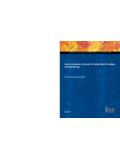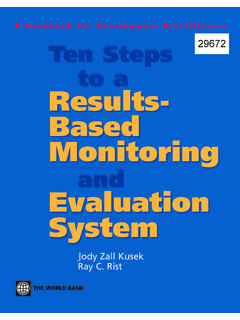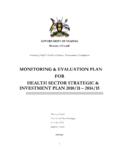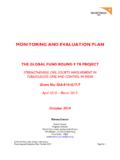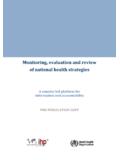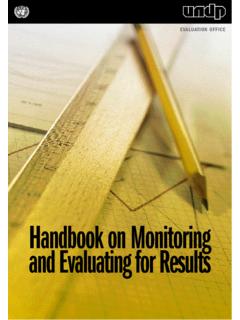Transcription of FOREWORD - samea.org.za
1 FOREWORDThe Proposal and Implementation Plan for a Government-Wide monitoring and EvaluationSystem: A publication for Programme Managers is the first comprehensive initiative monitoringand evaluation guideline after the cabinet of the Republic of South Africa approved a process toplan a monitoring and evaluation (M&E) system for use across government in purpose of this publication is to contribute to improved governance and enhance theeffectiveness of public sector organisations and institutions in South Africa. It was written tosupport the improvement of the collection and collation, analysis, dissemination and applicationof information on the progress and impact of programmes in order to ensure transparency andaccountability and to promote service delivery improvement and compliance with statutory andother requirements, as well as a learning culture in the public proposal aims specifically to.
2 Focus on the essential elements of results-oriented monitoring and evaluation thatrespond to the requirements of government s programmes, policies and projects fordecision-making, accountability and learning strengthen the role of the monitoring function within the three spheres of government present a more integrated approach to monitoring and evaluation functions ingovernment introduce simplified, streamlined and harmonised procedures in line with government sresults-oriented framework for monitoring and evaluation combined with practicalguidance for the development of selected instruments provide guidance on the assessment of results within a clearly defined framework orcontext of government programme of action and its priorities create greater attention to monitoring than in the past, to stress that both monitoring andevaluation are important management functions aimed at ensuring the quality ofinterventions and supporting decision-making, accountability.
3 Learning and publication is therefore intended for various levels of management within government,senior management, and technical, programme and project managers. It is divided into twoparts: Part One presents the conceptual and operational framework for monitoring andevaluation and implementation plan, while Part Two offers indicators for monitoring andevaluating programmes and projects at a macro 11/24/05 4:59 PM Page 12 The process of developing this proposal and implementation plan, as well as developmentindicators, coordinated by the Presidency, has been a collaborative effort by many people andwe would like to acknowledge their contributions.
4 Constructive insights from colleagues in Policy Coordination and Advisory Services (PCAS)were especially helpful throughout the process. Our thanks also go to the Office of the DG-DPSA, the M&E task team, GCIS for rigorous editorial and publication designs, as well as StatsSA for refining and reviewing the indicators in detail and providing useful comments trust that this publication will be a useful tool to those of you responsible for the managementof monitoring actions and the effective conduct of evaluation exercisesRev F ChikaneDirector-GeneralThe PresidencyProposal and Implementation Plan for a Government-wide monitoring and evaluation SystemProposal-changed 11/24/05 4.
5 59 PM Page 23 TABLE OF TO THE GOVERNMENT-WIDE monitoring ANDEVALUATION system Definition of monitoring and evaluation Background and rationale Lessons from international experience The quality of existing government monitoring and evaluation systems Other national information systems2. system USERS AND THEIR NEEDS Meeting the needs of diverse users The Presidency and Premiers Offices Centre of Government Decision-makers in public-service organisations and local authorities Oversight bodies The public 3. system AIMS, OBJECTIVES AND INTENDED RESULTS system aims and objectives Results to be achieved Programme logic and underlying assumptions Indicators of system success 4.
6 PERFORMANCE INDICATORS AND SOURCES OF INFORMATION Overview of the systems approach to indicators ANational Indicator Initiative Departmental indicators Transversal indicators Government Programme of Action Links to other sources 5. system REPORTS AND THEIR UTILISATION Issues to be addressed in system reports Proposal-changed 11/24/05 4:59 PM Page 34 Proposal and Implementation Plan for a Government-wide monitoring and evaluation system Composite indicators: a government performance dashboard Qualitative and impact studies Responses to information provided by the system 6. ROLES AND RESPONSIBILITIES system management and maintenance Institutional responsibilities Transversal responsibilities Capacity building APPENDIX AImplementation Strategy and Plan Strategic approach Projects required Implementation schedule APPENDIX B Transversal systems APPENDIX C Framework for Development Indicators for South Africa 2005 - 2014 Proposal-changed 11/24/05 4.
7 59 PM Page TO THE GOVERNMENT-WIDE monitoring ANDEVALUATION system Definition of monitoring and evaluation Background and rationale Lessons from international experience The quality of existing government monitoring and evaluation systems Other national information systems Definition of monitoring and evaluationMonitoring is a continuous managerial function that aims to provide managers, decision-makers and main stakeholders with regular feedback and early indications of progressor lack thereof in the achievement of intended results and the attainment of goals andobjectives. monitoring involves reporting on actual performance against what was planned or,expected according to pre-determined standards.
8 monitoring generally involvescollecting and analysing data on implementation processes, strategies and results, andrecommending corrective is a time-bound exercise that systematically and objectively assesses therelevance, performance, challenges and successes of programmes and can also address outcomes or other development usually seeks to answer specific questions to guide decision-makers orprogramme managers. evaluation should advise whether underlying theories andassumptions were valid, what worked, what did not work, and why. Evaluationcommonly aims to determine relevance, efficiency, effectiveness, impact andsustainability.
9 Background and rationaleThis document proposes the development of a government-wide monitoring andevaluation system (GWM&ES) that will deliver useful information and analysis andimprove monitoring and evaluation (M&E) practices and capacity, contributing to betterpublic management in South Africa. Proposal-changed 11/24/05 4:59 PM Page 56 Proposal and Implementation Plan for a Government-wide monitoring and evaluation SystemEffective management is a continuous cycle that starts with planning and that leads toimplementation and evaluation (PIE model). Implementation plans should be monitoredand evaluated, producing knowledge and insights that are fed back into planningprocesses.
10 Public management in South Africa has improved significantly since public service institution has been made accountable for their own management,leading to fundamental improvements in governance. The Public Finance ManagementAct and the implementation of the Medium Term Strategic and Expenditure Frameworkhave made it necessary to define and align activities and spending around clearlydefined objectives. These reforms have led to major improvements in planning andimplementation, and have encouraged a focus on service-delivery quality and impact. With decentralisation of accountability, line managers have become more responsiblefor non-core functions, such as human resources development and equity.
